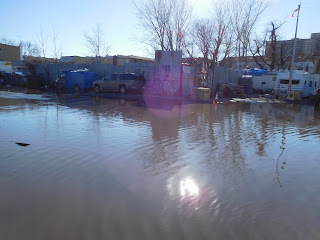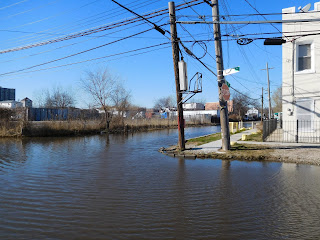It was spring-- almost summer, really--until I crossed the bridge.
In past years, I have noticed a seasonal change when I rode across the Cross Bay Veterans' Memorial Bridge. To be specific, when I'd be riding through Broad Channel--a shoestring of land dangling from the "mainland' of Queens--the temperature is about 20 to 22 degrees Celsius (68 to 72F) and I would feel the sun against my face. That is, until I reached the Bridge, which spans Jamaica Bay. While riding up the ramp to the bridge, the wind would whip waves on the water and I would feel the cold through whatever I was wearing. By the time I got to the Rockaways--another shoestring of land, this one splayed between the Bay and the Atlantic Ocean--the temperature would have fallen to about 10 degrees C (50F) but it would feel much colder.
I usually experience such momentary climate change in early or mid-April, when the ocean water might be about 8 degrees C (45F). But I had such an experience today. It was 64F (17C) when I left my apartment just before noon; the temperature would climb another few degrees by the time I reached Broad Channel. But, as I crossed the bridge, I was glad I'd brought an "extra" layer with me. (Is something "extra" when you end up needing it?) A thermometer in Rockaway Beach read 50F, but the wind--which I didn't notice until then--blew the cold from the very depths of the ocean. According to at least one source, the water was 41F (just over 5C) today. During the next few weeks, that temperature will fall by another couple of degrees to its seasonal low, which it reaches at the beginning of Spring.
I imagine that the water at Point Lookout, my destination today, was a little warmer, if only by a degree or two. Knowing that, I understand why down is such an effective insulator!
Anyway, I had a great ride: I saw a few other cyclists and joggers along the boardwalk and on the streets of Long Beach. As best as I could tell, they weren't wearing down.
In past years, I have noticed a seasonal change when I rode across the Cross Bay Veterans' Memorial Bridge. To be specific, when I'd be riding through Broad Channel--a shoestring of land dangling from the "mainland' of Queens--the temperature is about 20 to 22 degrees Celsius (68 to 72F) and I would feel the sun against my face. That is, until I reached the Bridge, which spans Jamaica Bay. While riding up the ramp to the bridge, the wind would whip waves on the water and I would feel the cold through whatever I was wearing. By the time I got to the Rockaways--another shoestring of land, this one splayed between the Bay and the Atlantic Ocean--the temperature would have fallen to about 10 degrees C (50F) but it would feel much colder.
I usually experience such momentary climate change in early or mid-April, when the ocean water might be about 8 degrees C (45F). But I had such an experience today. It was 64F (17C) when I left my apartment just before noon; the temperature would climb another few degrees by the time I reached Broad Channel. But, as I crossed the bridge, I was glad I'd brought an "extra" layer with me. (Is something "extra" when you end up needing it?) A thermometer in Rockaway Beach read 50F, but the wind--which I didn't notice until then--blew the cold from the very depths of the ocean. According to at least one source, the water was 41F (just over 5C) today. During the next few weeks, that temperature will fall by another couple of degrees to its seasonal low, which it reaches at the beginning of Spring.
I imagine that the water at Point Lookout, my destination today, was a little warmer, if only by a degree or two. Knowing that, I understand why down is such an effective insulator!
Anyway, I had a great ride: I saw a few other cyclists and joggers along the boardwalk and on the streets of Long Beach. As best as I could tell, they weren't wearing down.












































